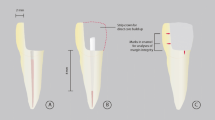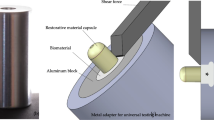Abstract
Objectives
The aim of this study was to evaluate the physical and mechanical properties of different dual functional cements.
Materials and methods
Three dual functional cements (Allcem Core (FGM), Rebilda DC (VOCO), and LuxaCore Z (DMG)), a luting resin cement (Rely X ARC (3 M ESPE)), and a Core Buildup composite resin GrandioSo (VOCO) were used. Flexural strength (n = 10) and film thickness (n = 6) were evaluated according to ISO 4049:2009. Flow (n = 6) was evaluated according to ISO 6876:2001. Degree of conversion (DC) was assessed immediately and 24 h after polymerization (n = 5). For resistance to dislodgment (RD) analysis, bovine teeth were prepared to receive fiber glass posts, and a push-out test (n = 12) was used.
Results
Luxacore Z presented lower flexural strength when compared to GrandioSo (p < 0.001). No statistical difference was found between cements for film thickness (p = 0.66). Reduced flow values were found for Allcem Core (p = 0.006). No statistical difference was found for immediate DC for different cements (p > 0.05). After 24 h, DC increased for all groups, except for Luxacore Z (p = 0.054). The RD did not differ from the control Rely X ARC, regardless of the root third (p > 0.05). Luxacore Z showed lower mean values in the apical third compared to the coronal third (p = 0.046).
Conclusions
The dual functional cements (Allcem Core and Rebilda DC) possessed similar physical and mechanical properties of luting resin cement (RelyX ARC) and Core Buildup composite resin (GrandioSo). Hence, they could be used for one-stage post and core buildup restorations.
Clinical relevance
The dual functional cements could be used for one-stage post and core buildup restorations since they possess similar physical and mechanical properties of luting resin cements and Core Buildup composite resin.

Similar content being viewed by others
References
Dietschi D, Duc O, Krejci I, Sadan A (2008) Biomechanical considerations for the restoration of endodontically treated teeth: a systematic review of the literature, part II (evaluation of fatigue behavior, interfaces, and in vivo studies). Quintessence Int Berl Ger 1985 39:117–129
Mjör IA, Smith MR, Ferrari M, Mannocci F (2001) The structure of dentine in the apical region of human teeth. Int Endod J 34:346–353
Bitter K, Noetzel J, Stamm O, Vaudt J, Meyer-Lueckel H, Neumann K, Kielbassa AM (2009) Randomized clinical trial comparing the effects of post placement on failure rate of postendodontic restorations: preliminary results of a mean period of 32 months. J Endod 35:1477–1482. https://doi.org/10.1016/j.joen.2009.07.026
Dietschi D, Duc O, Krejci I, Sadan A (2007) biomechanical considerations for the restoration of endodontically treated teeth: a systematic review of the literature--part 1. Composition and micro- and macrostructure alterations. Quintessence Int Berl Ger 1985 38:733–743
Cotes C, Cardoso M, de Melo RM et al (2015) Effect of composite surface treatment and aging on the bond strength between a core build-up composite and a luting agent. J Appl Oral Sci Rev FOB 23:71–78. https://doi.org/10.1590/1678-775720140113
Tay FR, Pashley DH (2007) Monoblocks in root canals: a hypothetical or a tangible goal. J Endod 33:391–398. https://doi.org/10.1016/j.joen.2006.10.009
Agrawal A, Mala K (2014) An in vitro comparative evaluation of physical properties of four different types of core materials. J Conserv Dent JCD 17:230–233. https://doi.org/10.4103/0972-0707.131782
Schmitter M, Rammelsberg P, Lenz J, Scheuber S, Schweizerhof K, Rues S (2010) Teeth restored using fiber-reinforced posts: in vitro fracture tests and finite element analysis. Acta Biomater 6:3747–3754. https://doi.org/10.1016/j.actbio.2010.03.012
Naumann M, Koelpin M, Beuer F, Meyer-Lueckel H (2012) 10-year survival evaluation for glass-fiber-supported postendodontic restoration: a prospective observational clinical study. J Endod 38:432–435. https://doi.org/10.1016/j.joen.2012.01.003
Bitter K, Schubert A, Neumann K, Blunck U, Sterzenbach G, Rüttermann S (2016) Are self-adhesive resin cements suitable as core build-up materials? Analyses of maximum load capability, margin integrity, and physical properties. Clin Oral Investig 20:1337–1345. https://doi.org/10.1007/s00784-015-1623-0
Sterzenbach G, Karajouli G, Tunjan R, Spintig T, Bitter K, Naumann M (2015) Damage of lithium-disilicate all-ceramic restorations by an experimental self-adhesive resin cement used as core build-ups. Clin Oral Investig 19:281–288. https://doi.org/10.1007/s00784-014-1263-9
ISO 4049 (2009) Dentistry - Polymer-based restorative materials. https://www.iso.org/standard/42898.html. Accessed 4 Feb 2018
ISO 6876 (2012) Dentistry - Root canal sealing materials. In: ISO. http://www.iso.org/iso/catalogue_detail.htm?csnumber=45117. Accessed 19 Jun 2016
Naumann M, Sterzenbach G, Rosentritt M, Beuer F, Meyer-Lückel H, Frankenberger R (2011) Self-adhesive cements as core build-ups for one-stage post-endodontic restorations? Int Endod J 44:195–202. https://doi.org/10.1111/j.1365-2591.2010.01797.x
Pulido CA, de Oliveira Franco APG, Gomes GM, Bittencourt BF, Kalinowski HJ, Gomes JC, Gomes OMM (2016) An in situ evaluation of the polymerization shrinkage, degree of conversion, and bond strength of resin cements used for luting fiber posts. J Prosthet Dent 116:570–576. https://doi.org/10.1016/j.prosdent.2016.02.019
Jager S, Balthazard R, Dahoun A, Mortier E (2016) Filler content, surface microhardness, and rheological properties of various Flowable resin composites. Oper Dent 41:655–665. https://doi.org/10.2341/16-031-L
Bahari M, Savadi Oskoee S, Kimyai S et al (2014) Effect of light intensity on the degree of conversion of dual-cured resin cement at different depths with the use of translucent Fiber posts. J Dent Tehran Iran 11:248–255
Zicari F, Couthino E, De Munck J et al (2008) Bonding effectiveness and sealing ability of fiber-post bonding. Dent Mater 24:967–977. https://doi.org/10.1016/j.dental.2007.11.011
Leitune VCB, Collares FM, Werner Samuel SM (2010) Influence of chlorhexidine application at longitudinal push-out bond strength of fiber posts. Oral Surg Oral Med Oral Pathol Oral Radiol Endod 110:e77–e81. https://doi.org/10.1016/j.tripleo.2010.04.046
Lopes C de CA, Rodrigues RB, Silva ALFE et al (2015) Degree of conversion and mechanical properties of resin cements cured through different all-ceramic systems. Braz Dent J 26:484–489. https://doi.org/10.1590/0103-6440201300180
Chávez-Lozada J, Urquía-Morales MDC (2014) In vitro evaluation of the film thickness of self-etching resin cements. Acta Odontol Latinoam AOL 27:145–150. https://doi.org/10.1590/S1852-48342014000300008
Rodrigues Junior SA, Zanchi CH, de Carvalho RV, Demarco FF (2007) Flexural strength and modulus of elasticity of different types of resin-based composites. Braz Oral Res 21:16–21
Provenzi C, Collares FM, Cuppini M et al (2018) Effect of nanostructured zirconium dioxide incorporation in an experimental adhesive resin. Clin Oral Investig:1–10. https://doi.org/10.1007/s00784-017-2311-z
Kremeier K, Fasen L, Klaiber B, Hofmann N (2008) Influence of endodontic post type (glass fiber, quartz fiber or gold) and luting material on push-out bond strength to dentin in vitro. Dent Mater 24:660–666. https://doi.org/10.1016/j.dental.2007.06.029
Rojpaibool T, Leevailoj C (2017) Fracture resistance of Lithium Disilicate ceramics bonded to enamel or dentin using different resin cement types and film thicknesses. J Prosthodont 26:141–149. https://doi.org/10.1111/jopr.12372
Tay FR, Loushine RJ, Lambrechts P et al (2005) Geometric factors affecting dentin bonding in root canals: a theoretical modeling approach. J Endod 31:584–589
Marques de Melo R, Bottino MA, Galvão RKH, Soboyejo WO (2012) Bond strengths, degree of conversion of the cement and molecular structure of the adhesive-dentine joint in fibre post restorations. J Dent 40:286–294. https://doi.org/10.1016/j.jdent.2012.01.003
Cerutti F, Acquaviva PA, Gagliani M, Ferrari M, Mangani F, Depero LE, Cerutti A (2011) Degree of conversion of dual-cure resins light-cured through glass-fiber posts. Am J Dent 24:8–12
Goracci C, Grandini S, Bossù M, Bertelli E, Ferrari M (2007) Laboratory assessment of the retentive potential of adhesive posts: a review. J Dent 35:827–835. https://doi.org/10.1016/j.jdent.2007.07.009
Bohrer TC, Fontana PE, Wandscher VF et al (2018) Endodontic sealers affect the bond strength of Fiber posts and the degree of conversion of two resin cements. J Adhes Dent:1–8. https://doi.org/10.3290/j.jad.a40301
Inokoshi M, Pongprueksa P, De Munck J et al (2016) Influence of light irradiation through zirconia on the degree of conversion of composite cements. J Adhes Dent 18:161–171. https://doi.org/10.3290/j.jad.a35842
Penelas AG, Piedade VM, Borges ACO d S, Poskus LT, da Silva EM, Guimarães JGA (2016) Can cement film thickness influence bond strength and fracture resistance of fiber reinforced composite posts? Clin Oral Investig 20:849–855. https://doi.org/10.1007/s00784-015-1568-3
Souza AC, Gonçalves Fde C, Anami LC, Melo RM, Bottino MA, Valandro LF (2015) Influence of insertion techniques for resin cement and mechanical cycling on the bond strength between fiber posts and root dentin. J Adhes Dent 17:175–180. https://doi.org/10.3290/j.jad.a33993
Altmann ASP, Leitune VCB, Collares FM (2015) Influence of eugenol-based sealers on push-out bond strength of Fiber post Luted with resin cement: systematic review and meta-analysis. J Endod 41:1418–1423. https://doi.org/10.1016/j.joen.2015.05.014
Author information
Authors and Affiliations
Corresponding author
Ethics declarations
Conflict of interest
The authors declare that they have no conflict of interest.
Funding
This study was not supported for source of founding.
Ethical approval
This article does not contain any studies with human participants or animals performed by any of the authors.
Informed consent
For this type of study, formal consent is not required.
Rights and permissions
About this article
Cite this article
Walcher, J.G., Leitune, V.C.B., Collares, F.M. et al. Physical and mechanical properties of dual functional cements—an in vitro study. Clin Oral Invest 23, 1715–1721 (2019). https://doi.org/10.1007/s00784-018-2598-4
Received:
Accepted:
Published:
Issue Date:
DOI: https://doi.org/10.1007/s00784-018-2598-4




